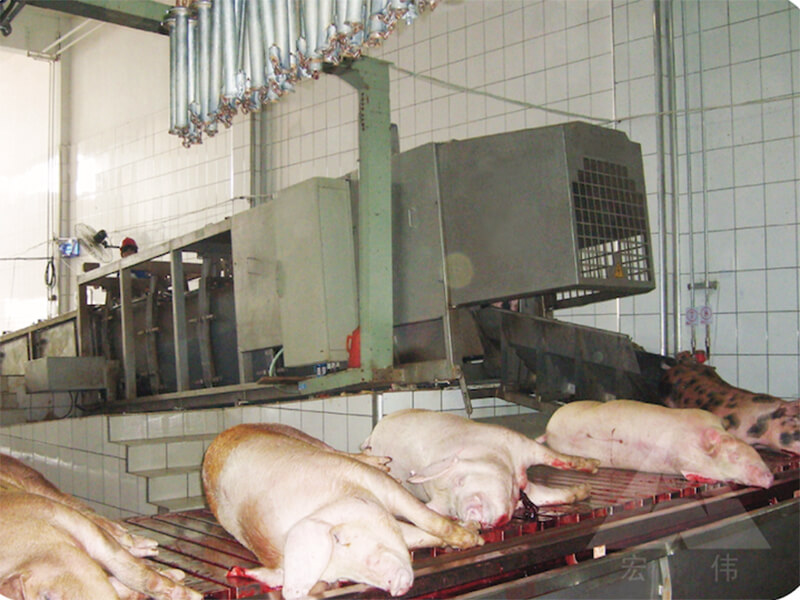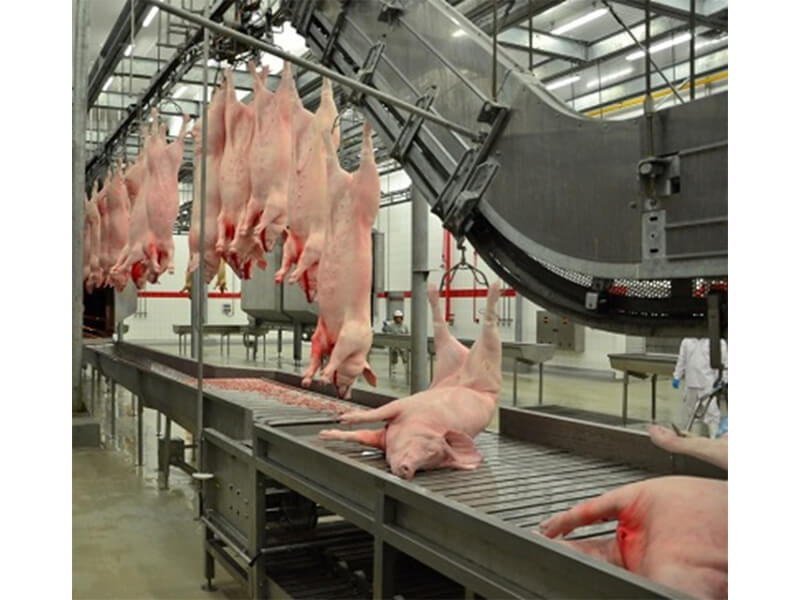
In the pig abattoir slaughter line, the process of killing and bloodletting follows the stunning process. There are two methods commonly used for this stage: horizontal bloodletting and hanging handstand bloodletting. Each method has its own distinct process and benefits. Let’s explore them in detail.
Method 1: Horizontal Bloodletting
In the horizontal bloodletting method, the stunned pig is directed onto a pig horizontal killing and bleeding conveyor through a chute. The pig is then killed and blood is let using a knife. During the bloodletting process, which typically lasts for 1-2 minutes, approximately 90% of the pig’s blood flows into a pig blood collection tank. (What are the main pig slaughtering equipments needed for modern hog abattoir? )

This method facilitates the efficient collection and utilization of blood, while also improving the overall slaughter capacity. It is considered a practical combination of a three-point automatic electric stunning conveyor pig slaughtering machine.
Method 2: Hanging Handstand Bloodletting
In the hanging handstand bloodletting method, the stunned pig is secured by chaining one of its hind legs with a pig or hog shackle. The pig is then lifted into the rail of a pig hanging bleeding conveyor shackle using a hoist or lifting device specifically designed for the pig bloodletting line. Once in position, the pig is killed and blood is let using a knife.

About the Automatic Pig Bloodletting Conveying Line
The automatic pig bloodletting conveying line incorporates a rail system with a height of no less than 3,400 mm from the workshop floor. This design ensures proper positioning and effective processing of the pig carcasses throughout the bloodletting stage.
The main processes carried out on the automatic pig bloodletting conveyor line include hanging (killing), bloodletting, pig carcass washing, and head cutting. The bloodletting duration is typically set at around 5 minutes to ensure thorough bleeding.
Following the killing and bloodletting stage, the next step in the pig slaughter line process is scalding and dehairing. This process involves immersing the pig carcasses in hot water to facilitate the removal of hair, followed by mechanical dehairing to achieve a clean and hair-free surface.
Conclusion
The killing and bloodletting stage in the pig slaughter line is a critical process that ensures the proper bleeding of the animal. Both the horizontal bloodletting and hanging handstand bloodletting methods offer effective means to accomplish this. The automatic pig bloodletting conveying line enhances efficiency and streamlines the workflow, enabling consistent and high-quality results. Understanding these processes is vital for maintaining hygiene, optimizing production, and ensuring compliance with industry standards in pig slaughterhouses.
If you want more information, please contact us by email or WhatsApp. You can add our WhatsApp by scanning the QR code on the right.

